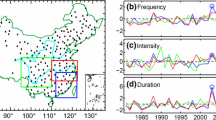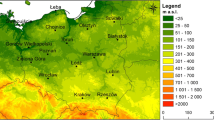Abstract
The surface and upper-level features associated with a sharp drop of wintertime daily temperature over South Korea is investigated in this study. This sharp drop in daily temperature is called a cold surge and is one of the most hazardous weather phenomena in East Asian winters. An upper-level baroclinic wave of 60° wavelength propagating eastward at a phase speed of 12° longitude per day across the continent of northern China from the west of Lake Baikal toward the eastern coast of China causes the outbreak of cold air over South Korea. The cooling associated with the upper-level baroclinic wave is found at all altitudes under the geopotential height-fall center near the tropopause. The development in the ridge seems to derive the early evolution of the eastward-propagating sinusoidal wave, whereas the trough is connected directly with the tropospheric temperature-drop. An enhancement of the wintertime East Asian jet stream after the outbreak of a cold surge is a response to the steep temperature gradient associated with the developing baroclinic wave.
Similar content being viewed by others
References
Bjerknes, J., 1966: A possible response of the atmospheric Hadley circulation to equatorial anomalies of ocean temperature.Tellus,18, 820–829.
Boyle, J. S., 1986: Comparison of the synoptic conditions in midlatitude accompanying cold surges over eastern Asia for the months of December 1974 and 1978. Part I: Monthly mean fields and individual events.Mon. Wea. Rev.,114, 903–918.
Boyle, J. S., and T.-J. Chen, 1987: Synoptic aspects of the wintertime East Asian monsoon.Monsoon Meteorology, C. P. Chang and T. N. Krishnamurti, Eds., Oxford University Press, 126–160.
Chang, C. P., and K. -M. Lau, 1980: Northeasterly cold surges and near-equatorial disturbances, Part II: Planetary-scale aspects.Mon. Wea. Rev.,108, 298–312.
Chen, T. -C., M. -C. Yen, W. -R. Huang, and W. A. Gallus Jr., 2002: An East Asian cold surge: Case study.Mon. Wea. Rev.,130, 2271–2290.
Cressman, G. P., 1981: Circulations of the West Pacific jet stream.Mon. Wea. Rev.,109, 2450–2463.
Ding, Y. H., 1994:Monsoon over China. Kluwer Academic Publishers, 432pp.
Hanson, H. P., and B. Long, 1985: Climatology of cyclogenesis over the East China Sea.Mon. Wea. Rev.,113, 697–707.
Holton, J. R., 1993:An Introduction to Dynamic Meteorology. 3rd ed., Academic Press, 511pp.
Hou, A. Y., 1998: Hadley circulation as a modulator of the extratropical climate.J. Atmos. Sci.,55, 2437–2457.
Joung, C. H., and M. H. Hitichman, 1982: On the role of successive downstream development in East Asian polar air outbreaks.Mon. Wea. Rev.,110, 1224–1237.
Keyser, D., and M. A. Shapiro, 1986: A review of the structure and dynamics of upper-level frontal zones.Mon. Wea. Rev.,114, 452–499.
Knox, J. L., and J. E. Hay, 1985: Blocking signatures in the northern hemisphere: Frequency distribution and interpretation.J. Climate,5, 1–16.
Lau, K. -M., and J. S. Boyle, 1987: Tropical and extratropical forcing of the large-scale circulation: A diagnostic study.Mon. Wea. Rev.,115, 400–428.
Lau, K. -M., J. S. Boyle, and M. T. Li, 1984: The monsoon of East Asia and its global association-A survey.Bull. Amer. Meteor. Soc.,65, 114–125.
Lim, G. H., and J. M. Wallace, 1991: Structure and evolution of baroclinic waves as inferred from regression analysis.J. Atmos. Sci.,48, 1718–1732.
Park, S. -U., and S. S. Kim, 1987: The synoptic conditions in the East Asian region accompanying cold-air outbreaks over Korea during December 1985 through Februry 1986.Journal of Korean Meteorological Society,23, 56–90.
Simmons, A. J., and B. J. Hoskins, 1979: The down-stream and upstream development of unstable baroclinic waves.J. Atmos. Sci.,36, 1239–1260.
Staff Members of Academia Sinica, 1958: On the general circulation over eastern Asia. Part II.Tellus,10, 58–75.
Zhang, Y., K. R. Sperber, and J. S. Boyle, 1997: Climatology and interannual variation of the East Asian winter monsoon: Results from the 1975–95 NCEP-NCAR Reanalysis.Mon. Wea. Rev.,125, 2605–2619.
Author information
Authors and Affiliations
Corresponding author
Rights and permissions
About this article
Cite this article
Ryoo, SB., Kwon, WT. & Jhun, JG. Surface and upper-level features associated with wintertime cold surge outbreaks in South Korea. Adv. Atmos. Sci. 22, 509–524 (2005). https://doi.org/10.1007/BF02918484
Received:
Revised:
Issue Date:
DOI: https://doi.org/10.1007/BF02918484




